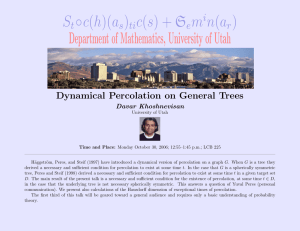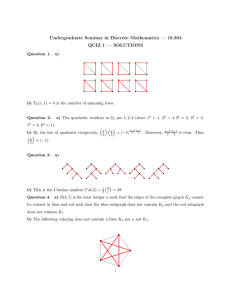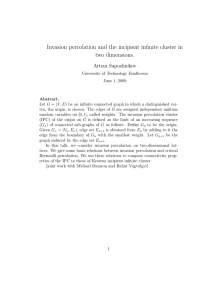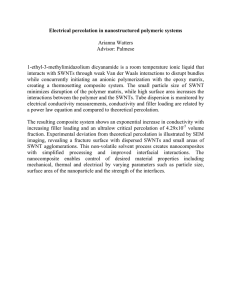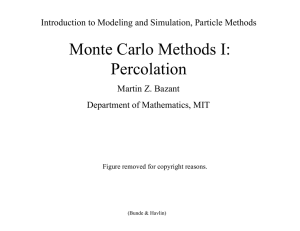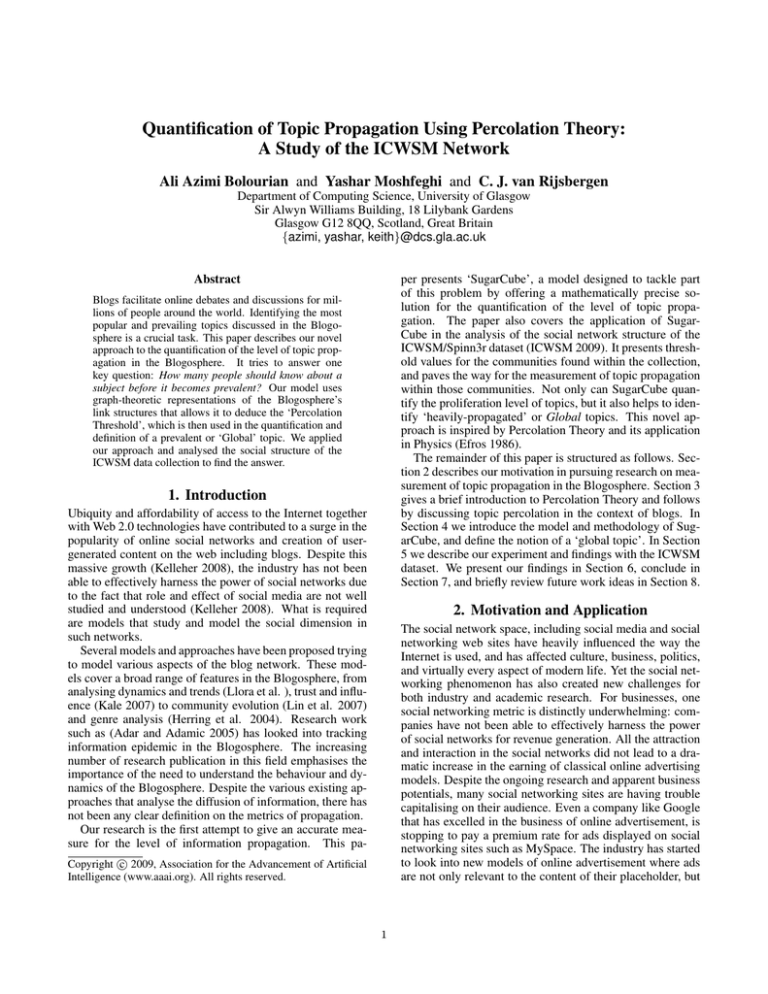
Quantification of Topic Propagation Using Percolation Theory:
A Study of the ICWSM Network
Ali Azimi Bolourian and Yashar Moshfeghi and C. J. van Rijsbergen
Department of Computing Science, University of Glasgow
Sir Alwyn Williams Building, 18 Lilybank Gardens
Glasgow G12 8QQ, Scotland, Great Britain
{azimi, yashar, keith}@dcs.gla.ac.uk
per presents ‘SugarCube’, a model designed to tackle part
of this problem by offering a mathematically precise solution for the quantification of the level of topic propagation. The paper also covers the application of SugarCube in the analysis of the social network structure of the
ICWSM/Spinn3r dataset (ICWSM 2009). It presents threshold values for the communities found within the collection,
and paves the way for the measurement of topic propagation
within those communities. Not only can SugarCube quantify the proliferation level of topics, but it also helps to identify ‘heavily-propagated’ or Global topics. This novel approach is inspired by Percolation Theory and its application
in Physics (Efros 1986).
The remainder of this paper is structured as follows. Section 2 describes our motivation in pursuing research on measurement of topic propagation in the Blogosphere. Section 3
gives a brief introduction to Percolation Theory and follows
by discussing topic percolation in the context of blogs. In
Section 4 we introduce the model and methodology of SugarCube, and define the notion of a ‘global topic’. In Section
5 we describe our experiment and findings with the ICWSM
dataset. We present our findings in Section 6, conclude in
Section 7, and briefly review future work ideas in Section 8.
Abstract
Blogs facilitate online debates and discussions for millions of people around the world. Identifying the most
popular and prevailing topics discussed in the Blogosphere is a crucial task. This paper describes our novel
approach to the quantification of the level of topic propagation in the Blogosphere. It tries to answer one
key question: How many people should know about a
subject before it becomes prevalent? Our model uses
graph-theoretic representations of the Blogosphere’s
link structures that allows it to deduce the ‘Percolation
Threshold’, which is then used in the quantification and
definition of a prevalent or ‘Global’ topic. We applied
our approach and analysed the social structure of the
ICWSM data collection to find the answer.
1. Introduction
Ubiquity and affordability of access to the Internet together
with Web 2.0 technologies have contributed to a surge in the
popularity of online social networks and creation of usergenerated content on the web including blogs. Despite this
massive growth (Kelleher 2008), the industry has not been
able to effectively harness the power of social networks due
to the fact that role and effect of social media are not well
studied and understood (Kelleher 2008). What is required
are models that study and model the social dimension in
such networks.
Several models and approaches have been proposed trying
to model various aspects of the blog network. These models cover a broad range of features in the Blogosphere, from
analysing dynamics and trends (Llora et al. ), trust and influence (Kale 2007) to community evolution (Lin et al. 2007)
and genre analysis (Herring et al. 2004). Research work
such as (Adar and Adamic 2005) has looked into tracking
information epidemic in the Blogosphere. The increasing
number of research publication in this field emphasises the
importance of the need to understand the behaviour and dynamics of the Blogosphere. Despite the various existing approaches that analyse the diffusion of information, there has
not been any clear definition on the metrics of propagation.
Our research is the first attempt to give an accurate measure for the level of information propagation. This pa-
2. Motivation and Application
The social network space, including social media and social
networking web sites have heavily influenced the way the
Internet is used, and has affected culture, business, politics,
and virtually every aspect of modern life. Yet the social networking phenomenon has also created new challenges for
both industry and academic research. For businesses, one
social networking metric is distinctly underwhelming: companies have not been able to effectively harness the power
of social networks for revenue generation. All the attraction
and interaction in the social networks did not lead to a dramatic increase in the earning of classical online advertising
models. Despite the ongoing research and apparent business
potentials, many social networking sites are having trouble
capitalising on their audience. Even a company like Google
that has excelled in the business of online advertisement, is
stopping to pay a premium rate for ads displayed on social
networking sites such as MySpace. The industry has started
to look into new models of online advertisement where ads
are not only relevant to the content of their placeholder, but
c 2009, Association for the Advancement of Artificial
Copyright Intelligence (www.aaai.org). All rights reserved.
1
also have a social dimension (Kaplan 2008) (Ante, Grover,
and Green 2007).
Moreover, the substantial increase in the content of social
media is putting pressure on information retrieval systems
and search engines. In a quest to provide the best possible service, search engines attempt to index everything. The
ever increasing volume of social content requires not only a
shift in indexing policies, but also a change in the way hardware, software, and human resources are assigned to different tasks. A search engine that can measure and predict
the prevalence of subjects would be able to allocate human
and computing resources more effectively to indexing, processing and storage of data and various other tasks. In the
online advertisement business, for instance, an ad campaign
with limited budget would be able to make optimal use of
their assets and resources by knowing the number of people
they need to be reaching before their campaign is considered to be a success in their target market. Likewise, an
online service would be able to offer improved personalisation services when the social network of its client base and
their interests are well-defined.
To sum up, despite this massive growth in social media, the industry has not been able to effectively harness the
power of social networks due to the fact that role and effect
of social media are not well studied and understood. (Kaplan 2008) (Ante, Grover, and Green 2007) (Kelleher 2008).
What is required are models that study the social dimension
in such networks. This research aims to address part of these
problems, i.e. help add a new social dimension by quantifying propagation levels. It provides the answer to this key
question: How many people should know about a subject
before it becomes prevalent?
may behave similarly when they approach the critical point.
It can therefore be said that the “geometry of disorder determines a number of properties of a system in the vicinity of
its critical point.” (Efros 1986)
Percolation Theory takes advantage of this relationship
between physics and geometry. Different structures and geometries can be associated to a certain lattice structure that
allows a precise application of the statistical-physical technique of PT. A number of lattices are well studied, and their
PT-related features are precisely known (Jeraldo 2008).
There are two basic types of percolation models. In the
first one, points are defined on an underlying lattice in such
a way that, in every lattice site there is a probability p for a
point to exist there. This is the site percolation model. In
the second one, bonds are defined between two neighboring
sites on a lattice. Each bond has a probability p to exist.
Accordingly, this model is called bond percolation. In both
cases, structures of connected points can be defined, in a way
that it is possible to create a path between any two points of
the cluster.
The value of the critical probability Pc in which the system would go through abrupt changes can be calculated precisely for some lattices in both site and bond percolation.
For the rest, Pc has no precise answer and numerical and
computational methods are used to derive useful approximates (Essam 1980) (Kesten 1982) (Stauffer 1994).
Topic Percolation in the Context of Blogs
The Blogosphere is not just a place to publish and express
opinions. Blogs facilitate online debates and discussions for
millions of people around the world. Some blog posts go
unnoticed and some attract the attention of other bloggers
and readers, and fuel debates and discussions.
The aim of this work is to find out the number of people
who should know about a subject before it becomes prevalent, i.e. the critical fraction of bloggers who are “actively
aware” of the topic. Active awareness is the situation in
which bloggers not only know about a certain subject, but
also engage in online debates and discussions about it and
use hyperlinks during the course of their activity. In other
words, active awareness is reflected in the Blogosphere by
the act of linking. Based on this definition, blog entries with
no in-coming and out-going links are ignored. To achieve
this, we first look into the subjects which are actively discussed in the Blogosphere, count the number of bloggers
engaged in each topic, and find out if it has attracted a ‘critical mass’.
In this context, it is useful to look at the network of blogs
as a graph, in which the vertices are blogs (representing
bloggers) and the edges are friendship (blogroll) links connecting vertices. Figure 1 illustrates such a graph along with
different levels of topic propagation: some topics emerge in
a corner of the Blogosphere and spread to only a few other
bloggers (Zone A in Figure 1); some attract more attention,
reach a larger group of actively-aware audience but eventually cease to propagate further and fail to capture the attention of a wider public (Zone B in Figure 1); and finally, those
topics that spread all over the Blogosphere (Zone C in Figure 1). We call this type of highly propagated topic a global
3. Percolation Theory
Since the inception of Percolation Theory (PT) by Broadbent and Hammersley (Frisch and Hammersley 1963) in
1957, the theory has been used to interpret an exceptionally
wide variety of physical and chemical phenomena. From
formation of the electrical properties of amorphous semiconductors and spontaneous magnetisation of a doped ferromagnetic, to spread epidemics and forest fires, Percolation Theory has been widely used in several branches of science (Efros 1986).
The problems best tackled by Percolation Theory are critical phenomena, which are characterised by a critical point
at which some of the properties of the system undergo abrupt
changes, such as the transition of a metal from its normal
form to its superconducting phase, or the spread of a manageable forest fire to an uncontrollable fire engulfing the forest (Efros 1986) (Stauffer 1994).
Despite the variation and irregularities in the physics of
critical phenomena, all of them share a common feature: in
the neighbourhood of the critical point, the system breaks
into blocks with different properties. The size of the blocks
grows until the system reaches the critical point. There is
no regularity in the geometry of these blocks in the vicinity of the critical point. However, due to the large size of
the blocks, the geometry is independent of the structure of
the system. Therefore systems of varied nature and structure
2
topic. Our objective is to define what level of spread constitutes a global topic, and develop a model based on PT to
quantify it.
gro
Blo
g
in k
ll L
h(
rap
g
Blo
x:
rte
Ve
)
BL
try
En
V
:
ex
ert
rap
kg
L in
)
EL
h(
y
ntr
gE
Blo
Figure 2: The Blogosphere consists of two hyperlink layers:
the Blogroll Links (BL) and the Entry Links (EL)
links between blogs. GBL represents the social network
structure of bloggers, provides valuable insight into each
blogger’s position within the blogging community, and reveals their likely sources of influence and information. The
spread of information within the social network depends on
the connectedness amongst bloggers which is reflected in the
structure of the BL graph.
Evidently, bloggers might have ways other than blogrolls
to access news and information (such as links they keep in
their browser bookmarks or receive in emails). However,
blogroll links are very explicit signs of bloggers’ preferred
connections and possible sources of influence.
The structure of the BL graph plays a significant role in
the spread of topics, and consequently is an important factor in determining the critical threshold in the SC model.
The probability for information to move from one person to
another within a well-connected community is much higher
than in a hypothetical community where people do not know
each other and never talk to one another. Therefore, the potential for topics to spread throughout a community such as
the Blogosphere depends on the level of connectivity between its members, namely the bloggers. This connectivity
is explicitly reflected in the BL graph, and will be used in
configuring the Percolation Graph later in this paper.
Figure 1: Schematic view of the propagation of topics within
a large network of blogs: Some topics only attract a few
bloggers (A), some reach a larger audience but fail to capture
public attention (B), and some reach a ‘critical mass’ and
become ‘global’ (C)
This is not the first use of Percolation Theory in modelling
social trends. Ahmed and Abdusalam (Ahmed and Abdusalam 2000), Takahashi and Murai (Takahashi 2004) and
Efros (Efros 1986) have proposed models based on Percolation Theory for various social phenomena, from the spread
of rumours in a local community to the social relationship in
the context of politics. However, to the best of our knowledge this is the first time a model is proposed for the analysis
of social structure in the Blogosphere based on Percolation
Theory.
In the following sections, the notion of global topic will be
defined and expanded within the framework of SugarCube
model.
4. Methodology and Model
SugarCube focuses on hyperlink analysis and differentiates
between friendship links and blog entry links as the approach in (Leskovec and McGlohon 2007). It utilises the
combination of the following three relationship structures
represented in graph-theoretic form:
Entry Link Graph (EL)
EL is a graph GEL (V, E) comprising of blog entries (represented by permalinks). EL edges are usually formed by
means of direct linking, commenting and trackbacks. As
illustrated in Figure 3, the EL graph is represented on a
2-dimensional plane called Blog-Time in which X-axis is
Time (T ), Y-axis consists of Blogs (B) in an arbitrary order,
and each permalink is a vertex v(B, T ) where v ∈ V in the
graph GEL , denoting the blog and time of the entry. Figure 3
schematically shows a number of weakly connected components (WCC) in Blog-Time. SugarCube intuitively assumes
that all the vertices in a particular subgraph are discussing
the same topic: that’s why they linked to each other.
The EL graph answers three key questions:
• How many weakly-connected components or topic-based
subgraphs exist?
• How many blogs are involved in each subgraph?
1. the graph of Blogroll Links (BL) also known as friendship
or readership links;
2. the graph of blog Entry Links (EL);
3. a Percolation Graph (PG).
In SugarCube, BL and EL graphs are two hyperlink layers
that together constitute the Blogosphere, as shown in Figure
2. These three graphs are described in more detail below.
Blogroll Link Graph (BL)
Blogroll Link graph, also known as friendship or readership graph, is a graph GBL (V, E) where vertices are blogs
(representing bloggers), and edges are blogroll or friendship
3
B (Blog)
Bn
...
In SugarCube, the value of z in PG is approximated to the
average in-degree value of GBL which indicates the average
number of readership for a blogger:
1 −
z ≈
ρ (v)
(1)
|V |
weakly connected
component 1
root
B14
B13
B12
v∈V
B11
−
where ρ (v) denotes the in-degree of vertex v. Vertices in
the lattice represent blogs. Propagation of topics is designated as a bond percolation problem in which bonds symbolise the spread of active awareness from one person to acquaintances within GBL with probability p.
weakly connected
component 2
B10
B9
B8
B7
B6
root
B5
B4
Global Topic
B3
B2
B1
root
d 1 d 2 d3 d 4
The exact solution to the bond percolation problem on the
Bethe lattice was first given by Fisher and Essam (1961)
and subsequently by (Sykes and Essam 1963). Percolation
Threshold Pc is the critical probability, in the vicinity of
which the topic percolates throughout the Blogosphere. In
other words, a critical number of people are actively aware
of the subject. Pc for the Bethe lattice is precisely computable:
1
Pc =
(2)
z−1
This indicates that if the probability p of bond connectivity between vertices (bloggers) exceeds Pc , then information
will percolate throughout the entire lattice. Pc denotes a tipping point for the propagation of a topic, and when p > Pc
that topic is said to have heavily percolated through the community of bloggers, and thus is considered to be a “global
topic”. In SugarCube, pi is the fraction of blogs (or bloggers) in GBL associated with a weakly connected component W CCi in GEL . Therefore, a topic is considered global
in a community if the fraction of bloggers who are actively
aware of it reaches Pc .
weakly connected
component 3
d 5 d6
d7
d8
d9 d10 d11 d12 d13
...
dm
T
(time)
Figure 3: Weakly connected components formed around
topics in the EL graph.
• What is the time-span of each discussion?
For instance, three weakly-connected components 1, 2 and
3 can be seen in Figure 3. Even though the discussion in
W CC3 consists of five entries, the number of blogs involved
in this discussion is only three: all five entries are posted by
blogs B1 , B2 , and B3 . It is also evident that the discussion
in W CC3 went on for six days. Similarly, the discussion in
W CC2 consists of 18 entries posted by 13 blogs during a
time span of 14 days. Consequently, the topic of W CC2 has
reached twice as many blogs as the topic of W CC3 . In other
words, the topic of W CC2 has attracted more attention and
percolated farther through the community of bloggers than
the other topics.
The Percolation Graph introduced in the next section provides a threshold or an index used in the identification of
heavily propagated or global topics.
Percolation Graph (PG)
Inspired by the Rumour Propagation model of A. L. Efros
in (Efros 1986), we adopt a lattice-based Percolation graph
in order to transform the propagation problem into a Percolation Theory problem. The lattice chosen for this purpose
is a Bethe lattice. This lattice was introduced by Hans Albrecht Bethe in 1935 within the context of statistical mechanics, and since then it has been used as an approximation
for models in 2 and higher dimensions (Bethe 1935) (Braga,
Sanchis, and Schieber 2005).
The Bethe lattice was chosen for three main reasons: percolation in the Bethe lattice starts from its “root” outwards,
resembling the spread of information from one person to the
wider social network. Also, the Bethe lattice has a configurable structure, its co-ordination number z (number of immediate neighbours of a lattice vertex) can be set according
to requirements. Moreover, due to its distinctive topological
structure, the statistical properties of the Bethe lattice are exactly solvable, and computationally inexpensive. A simple
Bethe lattice is shown in Figure 4.
Figure 4: Bethe Lattice with z = 4
The next section describes our experiment with the
ICWSM/Spinn3r collection.
5. Experiment Findings
Step I - Identification of Blog URLs
We traversed the whole collection and created a set of home
page URLs associated with all blog entry documents. A total
of 2,627,194 unique blog homepage URLs were identified
at this stage. Each blog homepage is assumed to represent a
blogger (person).
4
average in-degree of the component, chosen z value for PG
and the value of Percolation Threshold. Each component
represents a community of bloggers in the collection. For
each community presented in Table 2, the URL with the
highest degree is chosen to identify the community. We also
manually checked the identifier URL to see whether it looks
like a real blog or splog, etc.
Table 1: Basic statistics of the Blogroll graph GBL
Vertices Non-singleton vertices
Edges
2,627,194
1,089,223 11,839,763
Step II - Finding Blogroll Links
Each and every homepage URLs was crawled to retrieve its
set of blogroll (friendship) links. Out of all blogroll links
found for each URL, only the subset of links that intersected
the ICWSM collection were kept. This was to confine the
boundaries of the experiment within the limits of the dataset.
We experienced a 1.7% failure rate during our crawls, i.e.
could not retrieve home page data for 46,418 blogs. These
include blogs that no longer exist, and servers that rejected
our crawler bot.
With the exception of LiveJournal blogs, it was assumed
that all Blogroll links reside on blog homepages. LiveJournal however provides a different mechanism for its members to express friendship links within the LiveJournal community. Around 30% (precisely 778,628) of the blogs in
the collection are hosted by LiveJournal, thus we made sure
those friendship links were extracted properly.
Step V - Percolation Threshold
Based on the average in-degree value of each community,
we assigned a coordination number z to configure a suitable
Percolation graph. Consequently, the percolation threshold
Pc for each community was calculated, which are listed in
Table 2.
6. Discussion
Despite the relatively slow pace of change in the structure of
the BL graph, changes in a small number of vertices (such
as deletion of one highly-connected vertex) can dramatically
alter the structural characteristics of the graph, which in turn,
affects the configuration of the PG and consequently the
value of Pc .
The goal of this paper is to provide a means for deducing
the critical fraction of blogs that need to be overtaken for
percolation to materialise. This in turn provides us with an
index, to which we can compare the level of percolation or
level of globalness of sub-global topics. If n and Pc are the
existing and the critical fractions of actively aware bloggers
respectively, then the scalar value g could be defined as the
level of globalness:
n
(3)
g=
Pc
Step III - Blogroll Graph
A Blogroll Graph GBL (V, E) was created where vertices
are blogs (representing bloggers). Table 1 lists brief statistics on the number of vertices and edges of the graph. With
50,085 in-links, http://jsp.typepad.com has the largest indegree in the collection.
Figure 5 illustrates the distribution of in-degrees in GBL
on log-log scale. The head of the distribution follows a
power law P (k) ∼ k −α with the exponent α = 1.03.
7. Conclusion
We proposed a new model for the measurement of topic
propagation on the Blogosphere using Percolation Theory.
We then put our theory to practice by analysing the social
network within the ICWSM/Spinn3r collection. We then
computed the value of Percolation Threshold for all communities. The thresholds show the fraction of people within
each community who should know about a subject before
the topic of that subject becomes prevalent, thereby providing an accurate answer to our research challenge. We
proposed to use the notion ‘global’ for topics that pass the
threshold to indicate their prevalence. We also showed a
method for measuring the level of propagation of other (subglobal) topics by comparing them to the percolation threshold of the underlying community as an index.
To summarise, by undertaking this experiment we have:
105
Frequency
104
1000
100
10
1
100
1000
104
InDegree
• identified the potential application of Percolation Theory
in the measurement of topic propagation in the Blogosphere;
Figure 5: In-degree distribution of the BL graph
• proposed a novel approach based on Percolation Theory
that identifies the highly propagated topics, and defined
the notion of a Global topic;
Step IV - Communities
We identified 16,206 weakly-connected components (WCC)
in GBL , of which the largest one consists of 1,046,063 vertices. Table 2 lists the features of the top ten weakly connected components within the BL graph, together with the
• applied our theory to the large-scale ICWSM/Spinn3r
blog collection, extracted communities within the collec-
5
Table 2: Characteristics of the top ten communities within the ICWSM network of bloggers
Community size
1,046,063
1,166
117
83
72
64
60
56
50
49
Average ρ−
11.2630
3.3490
8.5213
13.1445
22.6666
2.6093
23.6
5.75
44.22
6.2653
z
11
3
9
13
23
3
24
6
44
6
Pc
0.1000
0.5000
0.1250
0.0833
0.0454
0.5000
0.0434
0.2000
0.0232
0.2000
Indentifier URL
http://jsp.typepad.com
http://financeausedcar.wordpress.com
http://sellandtellonline.com
http://megalizardfan.livejournal.com
http://cbkopf.exblog.jp
http://ownlink228.cocolog-nifty.com/blog
http://beaconbadge.livejournal.com
http://brummitt89.livejournal.com
http://tm675345.spaces.live.com
http://debbie-g.livejournal.com
Identified as
blog
splog
unknown1
blog
splog
splog
blog
blog
splog
blog
8. Acknowledgments
tion, computed Percolation Threshold for each community, and presented the results for the top 10 communities;
Special thanks to Microsoft Research Cambridge for generously funding part of this research, and to Information Retrieval Facility (IRF) for providing the computing infrastructure that made the experiments possible.
• paved the way for other researchers to further analyse the
structure of the EL graph and draw conclusions on the
propagation level of topics in the collection.
References
To the best of our knowledge, this is the first application of
Percolation Theory in the Blogosphere.
Adar, E., and Adamic, L. 2005. Tracking information epidemics in blogspace. WI ’05: Proceedings of the 2005
IEEE/WIC/ACM International Conference on Web Intelligence.
Ahmed, E., and Abdusalam, H. 2000. On social percolation and small world network. The European Physical
Journal B-Condensed Matter.
Ante, S. E.; Grover, R.; and Green, H. 2007. In search of
MyProfits. BusinessWeek.
Bethe, H. A. 1935. Statistical theory of superlattices.
In Proceedings of the Royal Society of London. Series
A, Mathematical and Physical Sciences, volume 150 (No
871), 552–575. The Royal Society.
Braga, G. A.; Sanchis, R.; and Schieber, T. A. 2005. Critical percolation on a bethe lattice revisited. SIAM review
47:349–365.
Efros, A. L. 1986. Physics and Geometry of Disorder.
Percolation Theory. Mir Publishers Moscow.
Essam, J. 1980. Percolation theory. Rep. Prog. Phys.
Frisch, H. L., and Hammersley, J. M. 1963. Percolation
processes and related topics. Journal of the Society for Industrial and Applied Mathematics 11(4):894–918.
Herring, S.; Scheidt, L.; Bonus, S.; and Wright, E. 2004.
Bridging the gap: A genre analysis of weblogs. System Sciences, 2004. Proceedings of the 37th Annual Hawaii International Conference on 11.
ICWSM. 2009. ICWSM 2009 Spinn3r Dataset. In Proceedings of the Third International Conference on Weblogs
and Social Media (ICWSM 2009).
Jeraldo, P. 2008. Critical phenomena in percolation theory.
guava.physics.uiuc.edu.
Kale, A. 2007. Modeling trust and influence on blogosphere using link polarity.
Further Work
Analysis of the EL Graph The next stage would be to
analyse the EL graph by extracting the WCCs formed by active discussions, counting the number of bloggers involved
in each discussion, and finding out if any of the discussions
have attracted a ‘critical mass’. We are currently undertaking further work into the ICWSM/Spinn3r collection to analyse the EL graph.
Evaluation Following the analysis of the EL graph, it will
be imperative to evaluate the results and examine the usefulness of SugarCube’s quantification method. One way to
accomplish this task is to study the correlation between the
percolation level of various topics, specially global ones, and
observable trends in the Blogosphere obtained using tools
such as buzz trackers, top-link classifiers, topic detectors and
other established and widely accepted methods.
Prediction The next major step in this research is to enhance the model so that it can predict the likelihood of a
topic in becoming global. We will investigate integrating
various approaches such as (Liben-Nowell and Kleinberg
2003) with definition of Percolation Threshold and our approach to keep BL and EL layers separate.
Non-blog Domain The Sugar Cube model uses the characteristics of a relationship network (BL) in order to deduce
the level of influence and propagation of ideas that are frequently published (blog posts in EL). In this sense, there are
other domains that share similar characteristics with the Blogosphere: The network of academic citations consists of
a relationship network (co-authorship) and frequently published work (academic papers). Similar qualities might also
be found in the network of industrial patents.
6
Kaplan, D. 2008. Social networks and profitability: Facebook, MySpace look beyond ads. The Washington Post.
Kelleher, K. 2008. MySpace and Friends Need to Make
Money. And fast. Wired Magazine.
Kesten, H. 1982. Percolation Theory for Mathematics.
Birkhauser.
Leskovec, J., and McGlohon, M. 2007. Cascading behavior
in large blog graphs. In SDM 2007.
Liben-Nowell, D., and Kleinberg, J. 2003. The link prediction problem for social networks. CIKM ’03: Proceedings
of the twelfth international conference on Information and
knowledge management.
Lin, Y.-R.; Sundaram, H.; Chi, Y.; Tatemura, J.; and Tseng,
B. 2007. Blog community discovery and evolution based
on mutual awareness expansion. WI ’07: Proceedings of
the IEEE/WIC/ACM International Conference on Web Intelligence.
Llora, X.; Yasui, N.; Welge, M.; and Goldberg, D. Analyzing trends in the blogosphere using human-centered analysis and visualization tools. Urbana 51:61801.
Stauffer, A. A. D. 1994. Introduction to Percolation Theory. CRC.
Sykes, M. F., and Essam, J. W. 1963. Some exact critical
percolation probabilities for bond and site problems in two
dimensions. Phys. Rev. Lett. 10, 3 - 4.
Takahashi, K. 2004. An application of percolation theory
to political science. necsi.org.
Notes
1. There is not enough information to make a certain judgement on
this URL.
7



